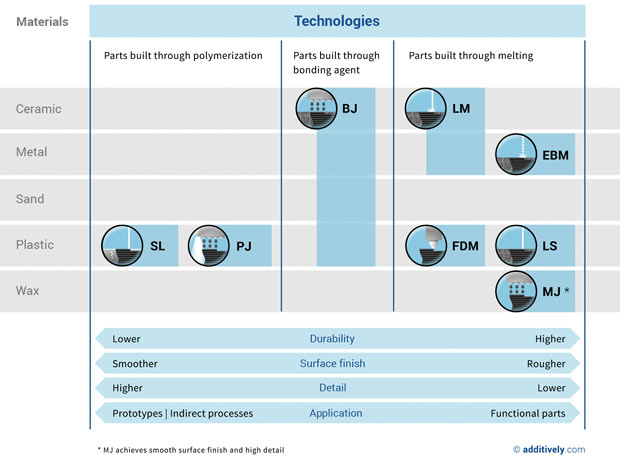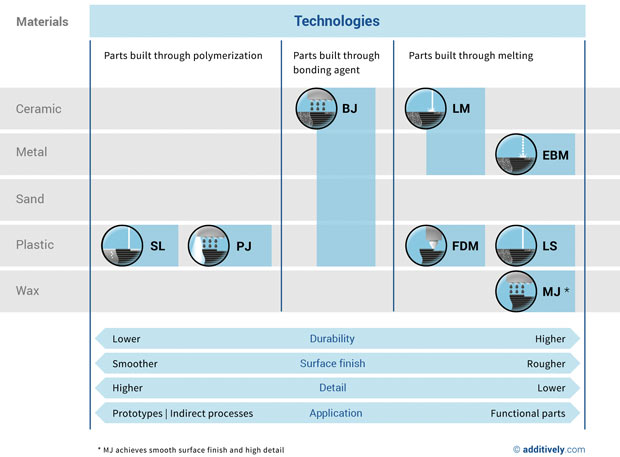
An overview of how 3D printing materials and technologies combine for different outcomes and applications. Illustration courtesy of Additively.com.Technology key: BJ (Binder Jetting), EBM (Electron Beam Melting), FDM (Fused Deposition Modeling), HP (Hybrid Processes), LM (Laser Melting), LS (Laser Sintering), MJ (Material Jetting), PJ (Photopolymer Jetting), SL (Stereolithography).
May 2, 2016
Most engineering professionals know 3D printing technology isn’t new — it’s actually been around for several decades. As the technology has evolved, more industrial users are applying it to address product complexity, time and budget constraints, as well as prototyping. Industries leading the way for industrial applications include aerospace, medical, automotive and dental.
According to research firm Gartner, in its 2014 report titled “3D Printer Market Survey Reveals Enterprise Demand Drivers for Technology, Printer and Vendor Decision Making,” early adopters of the technology were able to easily identify cost savings. “Respondents felt overwhelmingly that using a 3D printer as part of their supply chain generally reduces the cost of existing processes, especially research and product development costs,” said Pete Basilier, research director at Gartner. “The mean cost reduction for finished goods is between 4.1% and 4.3%, which is an impressive figure. It shows that early adopters of the technology are finding clear benefits, which are likely to drive further adoption.”
The market doesn’t show any sign of slowing down. Wohler’s Report 2016 stated the industry grew to $5.165 billion with a CAGR of 25.9%, and the number of industrial-grade AM system vendors rose from 49 to 62.
3D Printing Technology Primer
Since the invention of 3D printing, engineers and researchers have developed a variety of technologies that let users choose the optimal material and production method for their prototyping needs. While the processes vary in design constraints, material type and speed, most start by dividing a CAD file into thin layers to build a part, layer by layer. Here’s a brief look at each type of technology.
Stereolithography: To build a layer, a platform is lowered at set increments to expose a laser onto liquid photopolymer, hardening each layer until the part is fully built. After production is complete, the part is then treated with a solvent and exposed to ultraviolet light. Seen in both industrial and desktop systems, SLA can be used for prototyping and casting applications in aerospace, automotive, medical, consumer goods, dental and entertainment industries.
Fused Deposition Modeling: In addition to creating layers in the CAD file, FDM also accounts for support structures during a build. After heating thermoplastic to a semi-liquid state, an extruder deposits each layer on a print bed. Supports are printed in a removable material and then either broken away manually or dissolved with a liquid solution. This method is also known as fused filament fabrication (FFF) and is available in both large-scale, industrial and desktop 3D printers. It is the most common consumer/hobbyist 3D printing technology. Applicable industries for FDM prototyping and end-use parts include aerospace, automotive, consumer goods, medical and manufacturing.
Laser Sintering/Melting/Electron Beam Melting: Using a mirror, this process guides a laser or electron beam across a bed of powder-based polymers, ceramics and metals, fusing the particles. Once the print run is finished, the part is left to cool and may be smoothed out in postprocessing. Used in mainly industrial 3D printers, it is suited to aerospace, automotive, medical (including implants) and manufacturing sectors.
MultiJet/PolyJet/Photopolymer Jetting/Inkjet: The system’s extruder deposits a photopolymer layer while curing it with ultraviolet light to solidify the material. Support materials are printed in a separate material for simplified removal. Engineers can use this technology in both industrial and desktop systems for medical, dental, electronics and hobbyist use.
Digital Light Processing: Similar to stereolithography, this method will cure a photopolymer resin to build a prototype. The liquid photopolymer is exposed to light via a projector and solidifies. Upon completion, the production vat is drained of any excess liquid. Available for both industrial and desktop systems, DLP is often used for aerospace, automotive, dental, medical and manufacturing prototypes.
Laminated Object Manufacturing/Selective Deposition Lamination: Using a continuous sheet of plastic or paper, LOM uses heated rollers to spread the material and adhesive across the print bed and then cuts the desired design with a laser. SDL uses sheets of papers, selectively applies adhesive where needed and uses a blade to cut the paper. LOM/SDL is suited for manufacturing, medical, entertainment, engineering and educational uses.
Binder Jetting: To build each layer, these systems have a printhead that dispenses a binding material onto a layer of powder to form the part. Once the layer is completed, a roller will add a new powder layer. Postprocessing will vary depending on material; polymers require a secondary material for strength and metals and ceramics need to be thermally treated. Binder jetting is often used to create molds for casting, as well as color prototypes.
Material Jetting: For each layer, an extruder dispenses a melted wax material. Once the material cools and solidifies, a new layer is added. This technology is implemented for jewelry, electronics and dental applications.
Bioprinting: This process uses living cells and nutrient-rich microgels to create printed organs. A bioink of cells is extruded onto the print bed, together with — or separately into — the microgel that supports the living cells. To solidify the model, these systems can UV light, heat or other chemicals until the organ is finished. After a build, the tissue is set to mature for several weeks in a bioreactor. This technology is used specifically for medical applications.
 An overview of how 3D printing materials and technologies combine for different outcomes and applications. Illustration courtesy of Additively.com.
An overview of how 3D printing materials and technologies combine for different outcomes and applications. Illustration courtesy of Additively.com.
Technology key: BJ (Binder Jetting), EBM (Electron Beam Melting), FDM (Fused Deposition Modeling), HP (Hybrid Processes), LM (Laser Melting), LS (Laser Sintering), MJ (Material Jetting), PJ (Photopolymer Jetting), SL (Stereolithography).
Materials 101
Beyond the 3D printing technology itself, materials are a key consideration for prototyping and end-use parts. Materials can either be purchased directly from the 3D printer company or a third-party provider. However, some materials are proprietary. This means the type of materials that are available and compatible with your system will depend on the system itself and the 3D printing technology it uses.
Regardless of the technology, material selection does require some research. You should consider your application, the functionality you require from the 3D printed part, its geometry and postprocessing needs to help determine the appropriate material.
In narrowing down your application, it’s important to note any regulatory guidelines for material certification if your 3D-printed products are going to be on the market. This will help ensure that your materials won’t cause any compliance issues later in the development process.
Material properties such as heat and stress tolerance can help or hinder a product’s ability to function properly. If you know your part will require specific characteristics to function, be sure to include those properties in your material search.
With geometry, consider the dimensional tolerances, minimum feature execution and wall thickness. Materials can offer different resolutions and finishes depending on the 3D printing technology, and depending on how complex your geometries are, you may find that certain materials are more suitable than others.
Postprocessing is usually a part of the 3D printing process, and might add extra cost and time. Determine if your workflow has the time and/or resources for a 3D printing material with postprocessing needs, such as sanding, painting or surface finishing.
For more on specific materials, see the material glossary entries, which correspond with the table of industrial materials.
Subscribe to our FREE magazine, FREE email newsletters or both!
About the Author
Jess Lulka is a former associate editor for Digital Engineering. Contact her via [email protected].
Follow DE





